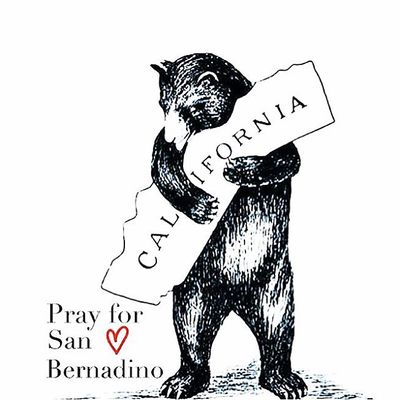
After the San Bernardino shooting, an image started picking up steam on Facebook and other social networks: a picture of a bear hugging the state of California. Though it has the twee aesthetic of a heartfelt millennial meme, it’s actually a drawing from 1913, off a set of sheet music for the state song, “I Love You, California.”
It’s the latest simple illustration to take over social media in the wake of a major tragedy. In the hours after 130 people were shot and killed in Paris, Facebook was filled with shared sketches of a peace symbol containing the Eiffel tower, an image by the French artist Jean Jullien, to say nothing of the millions of Facebook profile pictures given a tricolore overlay. After the shootings at Charlie Hebdo earlier this year, Instagram and Facebook lit up with a cartoon by the French artist Lucille Clerc, mistakenly attributed to Banksy.
It’s understandable to take to social media to respond to tragedy, even if it does sometimes seem shallow or hollow — we’re conditioned now to perform our emotions and reactions on public platforms, and the experience of watching horror on the news can give rise to a peculiar sensation of alienation and helplessness that can sometimes only be cured with small, seemingly meaningless actions. (The Onion nailed this feeling with its classic post-9/11 piece “Not Knowing What Else to Do, Woman Bakes American-Flag Cake.”) But why this recent emphasis on illustration and art?
Reposting the California bear image provides an easy shortcut for us to express ourselves online in a situation where saying much of anything is difficult . We have to do something. Social media constantly urges us to speak, to discuss what’s going on in the world around us with our friends and followers. But weighing in with strong opinions in the midst of a breaking-news event, when Twitter spectators thousands of miles away don’t even know what’s going on, is usually unwise. Tweeting an adage about “thoughts and prayers” might demonstrate that we’re aware of the situation without passing judgment on any party. But “prayers” are as fraught as anything else. The adage might be a way to fake action rather than express sincere solidarity, or simply have your intentions misunderstood. Who are you praying for, and are you actually praying? (Or are you “prayer-shaming”?)
Visual art, on the other hand, has become a perfect meme of grief. The web is an inherently visual medium, and when you’re being assaulted with unbearably sad text updates or horrifying photographs, a smartly presented image can feel like a respite from the cruelties of the word. A good illustration can demonstrate awareness, sympathy, and solidarity with victims, without taking sides or expressing ideological opinion. Many of the image memes are hokey, yes, but hokiness is forgivable in the face of expediency.
The grief meme goes way beyond the California bear. We’ve long trusted visual art to comfort and speak for us in trying times. You’d have some trouble sharing Picasso’s Guernica, since it’s on a 25-foot canvas, but the artist’s iconic peace doves have become, well, icons. The California bear and the Paris peace sign might not appear in the Prado anytime soon, but they serve fundamentally different functions than museum pieces.
There’s nothing to dislike about Jullien’s peace sign — it’s succinct, positive, and transparent. Like any good meme, it reproduces itself on protest signs and T-shirts, spawning riffs and remixes. “It’s an image for everyone. It’s a communication tool for people to express solidarity and peace and that’s what it’s being used for,” Jullien told Wired. “I think people have an instinctive sense of how to use these forms of communication. In cases like this, the things that need to spread, spread.” (Annie Galvin of 3 Fish Studios in San Francisco, who made one popular riff on the California bear meme, declined to comment on the image’s popularity after the tragedy.)
Social media may speed the process of image-focused public grieving, but it didn’t start there. In the aftermath of 9/11, Milton Glaser’s iconic I Love New York More Than Ever later appeared on posters and T-shirts. The content doesn’t matter so much as the vehicle. The grief meme has to be easily accessible, easily repostable, and as catchy as an ad slogan.
This kind of advertising-like frictionless lends a certain tension to the grief meme — does it actually help us express emotion, or is it just a glib way to place ourselves at the center of tragedy? The answer is some combination of both.
We value posting the image because speech is cynical, and a picture can mean whatever we want without us having to verbalize it, at the risk of offending some of our audiences on social networks. The desire for such a meme is a natural and valid reaction to incidents that seem like they come from nowhere, though they come from us, and strike the entire country with inarticulate tragedy. The victims are in such pain, politicians don’t care, and no amount of media coverage helps. We turn to grief memes when words fail our feelings, when we are yearning to address something that no writing of our own can quite embody, but we want to share in it anyway.
Still, there’s a deadening quality when the same image or phrase is repeated so many times over. It gradually loses its punch, even if every post is meant sincerely. I would argue this is because the grief meme has more utility to its user than its consumer — that is, it means more to post and share the meme than it does to see it.





























